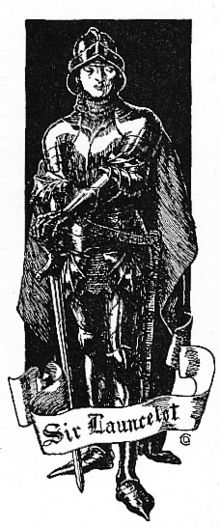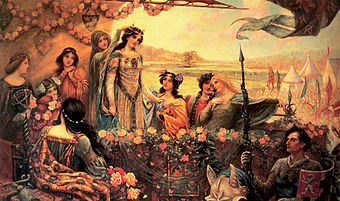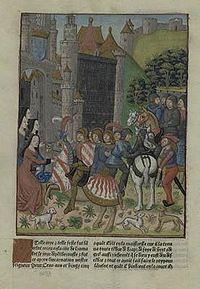- Lancelot
-
Sir Lancelot (or Launcelot) du Lac (
 /ˈlænsələt/, /ˈlɔːnsələt/, /ˈlænsəlɒt/, or /ˈlɔːnsəlɒt/; and /djuːˈlæk/ or /djuːˈlɑːk/) is one of the Knights of the Round Table in the Arthurian legend. He is the most trusted of King Arthur's knights and plays a part in many of Arthur's victories. He is perhaps most famous for being intimate with Arthur's wife Guinevere and the role he plays in the search for the Holy Grail.
/ˈlænsələt/, /ˈlɔːnsələt/, /ˈlænsəlɒt/, or /ˈlɔːnsəlɒt/; and /djuːˈlæk/ or /djuːˈlɑːk/) is one of the Knights of the Round Table in the Arthurian legend. He is the most trusted of King Arthur's knights and plays a part in many of Arthur's victories. He is perhaps most famous for being intimate with Arthur's wife Guinevere and the role he plays in the search for the Holy Grail.Lancelot's life and adventures are featured in several Medieval romances, often with conflicting backstories and chains of events. His first appearance as a main character is in Chrétien de Troyes' Le Chevalier de la Charette, or "Lancelot, the Knight of the Cart", dating from the 12th century.[1] In the 13th century, he figures prominently in the lengthy Vulgate Cycle, with the majority of his more famous exploits occurring in the section known as the Prose Lancelot.
Contents
Origins
Pre-Romance origins
Lancelot's literary origins are mysterious. Prior to his appearance in the works of Chrétien de Troyes, Lancelot is virtually unknown. Scholar Roger Sherman Loomis suggests that Lancelot is related to the Welsh hero Llwch Llenlleawg ("Llwch of the Striking Hand") from Culhwch and Olwen.
Lancelot may have instead been the hero of an independent folk-tale which had contact with and was ultimately absorbed into the Arthurian tradition: the theft of an infant by a water-fairy, the appearance of the hero at a tournament on three consecutive days in three different disguises, and the rescue of a queen or princess from an Other-World prison are all features of a well-known and widespread tale, variants of which are found in almost every land, and numerous examples of which have been collected by Emmanuel Cosquin in his Contes Lorrains, and by J. F. Campbell in his Tales of the West Highlands. Lancelot was said to have coal black hair, tanned skin and a handsome face.
Earliest appearance
The character Lancelot is first introduced by the writer Chrétien de Troyes who wrote in the 12th century. In Chrétien's earliest known work, Erec and Enide, the name Lancelot appears as third on a list of knights at King Arthur's court. The fact that Lancelot's name follows Gawain and Erec indicates the presumed importance of the knight at court, even though he does not figure prominently in Chrétien's tale. Lancelot reappears in Chrétien's Cligès. Here, Lancelot takes a more important role as one of the knights that Cligès must overcome in his quest.
It is not until Chrétien's Le Chevalier de la Charrette, however, that Lancelot becomes the protagonist. In this text, he is presented as the most formidable knight at King Arthur's court. His adulterous relationship with the Queen is also introduced in this text. According to Pamela Raabe, in Chrétien de Troyes’ work, Lancelot is portrayed as not only the bravest of knights, but one that everyone he meets is forced to describe as uniquely perfect. His deeds are recounted for their uniqueness, not only among living knights, but of all men who have ever lived. The problem is that critics have been unable to agree on how to reconcile his perfect “saintliness” with his obvious adultery with King Arthur’s Guinevere. How can the lovers’ consummation be considered a “saintly affair” when it is also adultery? And against King Arthur, to whom William Bowman Piper suggests all knights owe selfless respect, according to Arthurian politics. It also Chrétien who first gives Lancelot the name Lancelot du Lac (“Lancelot of the Lake”)[2] which was later picked up by the Anglo-French Lancelot-Grail and then Malory.[3]
Lancelot is constantly tied to the Christianity associated with Arthurian Legend. Raabe compares Lancelot’s quest for Guinevere in “Lancelot, the Knight of the Cart,” as a quest likening to Everyman’s quest for salvation and Christ’s quest for the human soul. This becomes intensified when he becomes the prophesied savior of the captives of Logres. His adventure among the tombs is described in terms that suggest Christ’s “harrowing of Hell” and resurrection: he effortlessly lifts the lid off the sarcophagus, which bears an inscription foretelling his freeing of the captives.
Danielle MacBain’s study of Thomas Malory’s “Le Morte d’Arthur,” claims Lancelot’s affair with Guinevere is often seen as parallel to that of Tristram, or Tristan, and Iseult. MacBain suggests that it is Lancelot who is ultimately identified with the tragedy of chance and human failing that is responsible for the downfall of the round table.
Although Lancelot will be later associated with the Grail Quest, Chrétien does not include him at all in his final romance, Le conte du graal. In this story, which introduces the Grail motif in medieval literature, Perceval is the sole seeker of the grail. Lancelot's involvement in the Grail legend is first recorded in the Perlesvaus written between 1200 and 1210.[4]
Later amplifications
Lancelot's character is perhaps most fully developed in the so-called Vulgate Cycle, where he appears prominently in the third and fourth parts, known as the Prose Lancelot (or Lancelot du lac) and the Queste del Saint Graal (or The Quest for the Holy Grail) respectively. While Gaston Paris argues that the Guenivere-Meleagant episode of the Prose Lancelot is an almost literal adaptation of Chrétien's poem,[citation needed] the Prose Lancelot can be seen as a considerable amplification of Chrétien's tale. Whereas Chrétien treats Lancelot as if his audience were already familiar with the character's background, most of the exploits associated with Lancelot today are first mentioned here (e.g. Lancelot's parentage, Lancelot and the Grail, Lancelot, Guenivere and the fall of Camelot, etc.).
Knighthood and adventures
Birth and childhood
Lancelot (born Galahad)[5] is the son of King Ban of Benwick (or Benoic) and Elaine.[6] While Lancelot is an infant, his father is driven from his kingdom, seen in Britain, by his enemy Claudas de la Deserte.[7] Ban and Elaine flee, carrying the child with them. As Elaine is tending to her wounded husband, Lancelot is carried off by the Lady of the Lake who raises the child in her magical kingdom. It is from this upbringing that Lancelot earns the surname, du lac (English: "of the lake").
Early adventures
The Lady of the Lake sends him to King Arthur's court, where he becomes a knight at the behest of Sir Gawain. Almost immediately upon his arrival, Lancelot falls in love with the Queen, and one of his very first adventures is rescuing Guinevere from Arthur's enemy, Meleagant[8] (however, in Le Morte D' Arthur, this rescue takes place after the adventures of the Sangreal). Lancelot seems to be related to a Celtic abduction tale called the aithed. In this legend, a mysterious stranger kidnaps a married woman and takes her to his home. The husband of the woman then rescues her against insurmountable odds.[9]
Early in Lancelot's career, he faces the Dolorous Guard. After setting out for adventure, Lancelot comes across a castle guarded by the Copper Knight. To overcome this challenge, Lancelot must battle ten knights at the first wall, ten knights at the second wall, and finally the Copper Knight himself. However, after defeating many more than twenty knights (with the aid of his foster mother, the Lady of the Lake), he discovers that the Copper Knight has fled. The townspeople lead Lancelot to a cemetery, where he finds a metal slab stating that only one knight can lift the slab and that this knight's name is written beneath the slab. Lancelot (who has heretofore been known as simply the "White Knight") is able to lift it and discovers that his name is, in fact, Lancelot.
The name of the Dolorous Guard is changed to the Joyous Guard and becomes Lancelot's home.
Lancelot plays an important role in a war between Arthur and Galehaut. Although Galehaut is Arthur's enemy, Lancelot befriends him and convinces him to surrender peacefully to Arthur. As a token of thanks, Arthur invites Lancelot to become a member of the Round Table. In spite of this happy outcome, Galehaut is the one who finally convinces Guinevere to return Lancelot's affection, an action that at least partially results in the fall of Camelot. Rather than return to Galehaut's court, Lancelot remains at the Round Table.
Later, with the help of King Arthur, Lancelot defeats Claudas and recovers his father's kingdom, though he again decides to remain at Camelot with his cousins Sir Bors and Sir Lionel and his illegitimate half-brother Ector de Maris.
Lancelot, Galahad, and the Grail
By this time, Lancelot is one of the most famous knights of the Round Table and Elaine, daughter of the Fisher King, falls in love with him. She tricks him into believing that she is Queen Guinevere, and he sleeps with her, and the ensuing pregnancy results in the birth of Galahad.
Word returns to Queen Guinevere and in a fit of rage, she banishes Lancelot after subjecting him to a long tirade criticizing him for his behavior. Broken by this rejection, Lancelot loses his wits and wanders the wilderness for two years until he arrives at Corbin. Elaine recognizes him, and he is shown the Holy Grail through a veil that cures his madness. Shortly after he recovers, he returns to Camelot after being found by Sir Percival and Sir Ector at a repentant Queen Guinevere's request.
Upon his return to court, Lancelot takes part in the Grail Quest with Perceval and Galahad, though as an adulterer and a man minded of earthly honors that have come with his knightly prowess, he is only allowed a glimpse of the Grail itself. It is instead his son, Galahad, who ultimately achieves the Grail, (along with Lancelot's nephew, Sir Bors, and Sir Perceval the son of King Pellinore).
Later years and death
Ultimately, Lancelot's affair with Guinevere is a destructive force, resulting in the death of Gawain's brothers, the estrangement of Lancelot and Gawain, and Mordred's betrayal of King Arthur. Upon hearing the news of Arthur's death, Lancelot finds that Guinevere has become a nun. She blames all the destruction of the Round Table upon her and Lancelot's love, which, indeed, according to Le Morte D'Arthur, is the seed of all the dismay that followed. She refuses to kiss Lancelot one last time, tells him to return to his lands, and that he will never see her face again. Instead, Lancelot declares that if she will take upon her a life of penitence, then so will he. He then retires to a hermitage to live out the rest of his life in penitence, with eight of his kin, including Sir Bors, joining him at the hermitage. He eventually becomes a priest, later conducting rites over the deceased body of Guinevere (who has become an abbess). As she had indicated, he never saw her face again in life. She had prayed that she might die before he arrived, and so she did, half-an-hour before his arrival (he had been told to go due to a dream he had had the night before).
After the queen's death, Lancelot and his fellow knights escort her body to be interred beside King Arthur (it was in the same place that Gawain's skull was kept). Lancelot, distraught for the loss of his beloved king and queen, begins to fail. In fact, even before this time, Le Morte D' Arthur states that he had lost a cubit of height due to his penitent fastings and prayers. Six weeks after the death of the queen, Lancelot dies. It is implied that he wished to be buried beside the king and queen; however, because he had some time before made a vow to be buried at Joyous Gard, he asks that he be buried there so as not to break his word.
After Lancelot's death, according to Le Morte D'Arthur, the eight knights of his kindred that had joined him in living a life of penitence, return to France, take care of the affairs of their lands, then, acting on Lancelot's request of them, go to the Holy Land and fight against the Turks. There they died on Good Friday, fighting against the Moors.
It is possible that originally Lancelot's tale did not include an affair with Guinevere, as the German Lanzelet knows nothing of it. The original tale may have been simply about a youth who was raised by a lake fairy. It is possible that Lancelot has a prototype in Welsh Celtic lore.
Notes
- ^ Sir Lancelot Online
- ^ Chretien de Troyes and the Dawn of Arthurian Romance - Page 13 William Farina - 2010 "Strictly speaking, the name Lancelot du Lac (“Lancelot of the Lake”) first appears in Chrétien's Arthurian debut, Erec and Enide (line 1674), as a member of the Roundtable."
- ^ A companion to Malory - Page 170 Elizabeth Archibald, Anthony Stockwell Garfield Edwards - 1996) "This is the book of my lord Lancelot du Lac in which all his deeds and chivalric conduct are contained and the coming of the Holy Grail and his quest (which was) made and achieved by the good knights, Galahad, ...".
- ^ Grail Legends (Perceval's Tradition)
- ^ Lancelot du lac, p. 40
- ^ Lancelot at the Camelot Project
- ^ Lancelot du lac
- ^ Le Chevalier de la charette
- ^ Kibler, William W., The Romance of Arthur, New York & London, Garland Publishing,Inc. 1994 pg.121
References
 This article incorporates text from a publication now in the public domain: Chisholm, Hugh, ed (1911). Encyclopædia Britannica (11th ed.). Cambridge University Press.
This article incorporates text from a publication now in the public domain: Chisholm, Hugh, ed (1911). Encyclopædia Britannica (11th ed.). Cambridge University Press.- MacBain, Danielle Morgan. "The Tristramization of Malory's Lancelot." English Studies, 74(1993): 57-66.
- Piper, William Bowman. "The Whole Book of King Arthur and of His Noble Knights." Modern Language Quarterly, 47(1986): 219-35.
- Raabe, Pamela. "Chretien's Lancelot and the Sublimity of Adultery." Toronto Quarterly, 57(1987): 259-70.
Further reading
- Lancelot and the Grail: A Study of the Prose Lancelot, Elspeth Kennedy (Clarendon Press, 1986)
- Lancelot Do Lac, the Non-Cyclic Old French Prose Romance, Two Volumes, Elspeth Kennedy (ed.) (OUP, 1980)
- Lancelot of the Lake, Introduction Elspeth Kennedy. Translation and notes Corin Corley (Oxford World's Classics)
- William Cole. "First and Otherwise Notable Editions of Medieval French Texts Printed from 1742 to 1874: A Bibliographical Catalogue of My Collection". Sitges: Cole & Contreras, 2005.
- The Princess, the Crone, and the Dung-Cart Knight, Gerald Morris (2008)
- K. Sarah-Jane Murray, "From Plato to Lancelot: A Preface to Chretien de Troyes," Syracuse University Press, 2008. ISBN 0-8156-3160-X
- Grail, Stephen R. Lawhead (Avon Books, 1997)
External links
- The Charrette Project 2 at Baylor University
- XVth century Lancelot manuscripts BNF fr. 113-116 Bibliothèque Nationale de France, selection of illuminated folios, Modern French Translation, Commentaries.
Monty Python and the Holy Grail Characters King Arthur | Sir Lancelot | Sir Galahad | Sir Bedevere | Knights who say Ni | Tim the Enchanter | Black Knight | Rabbit of Caerbannog | PatsyLocations Miscellaneous King Arthur and the Matter of Britain Key people King Arthur · Constantine · Sir Ector · Duke of Cornwall · Guinevere · Igraine · Iseult · Lady of the Lake · King Lot · King Mark · Merlin · Mordred · Morgan le Fay · Morgause · Uther PendragonKnights of the
Round TableAgravain · Bagdemagus · Bedivere · Bors · Breunor (La Cote Mal Taillée) · Calogrenant · Caradoc · Dagonet · Dinadan · Gaheris · Galahad · Gareth · Gawain · Geraint · Griflet · Hector de Maris · Kay · Lamorak · Lancelot · Leodegrance · Lionel · Lucan · Maleagant · Marhaus · Palamedes · Pelleas · Pellinore · Percival · Safir · Sagramore · Segwarides · Tor · Tristan · Uriens · Ywain · Ywain the Bastard · Elyan the White · Sir EctorObjects Places In media Other Sir Balin · Dolorous Stroke · Elaine of Astolat · Elaine of Corbenic · Fisher King · Green Knight · King Arthur's messianic return · King Arthur's family · Historical basis for King Arthur · Claudas · Emperor Lucius · Questing BeastCategories:- Knights of the Round Table
- French folklore
- Monty Python and the Holy Grail
- Monty Python characters
- Holy Grail
Wikimedia Foundation. 2010.



